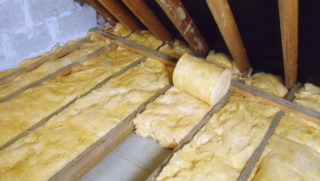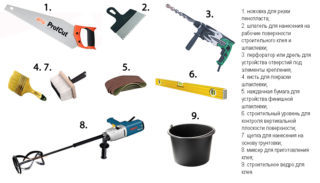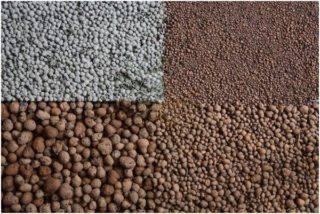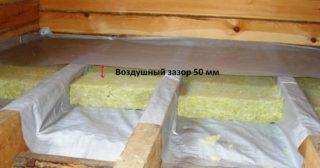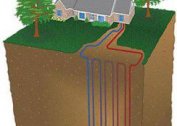Insulation of the ceiling ensures the warmth of the rooms in the winter and coolness in the summer. This should be done even during the construction of the building. If the building was purchased ready, it is possible to do the insulation of the ceiling in a private house from the inside with little cost.
Choice of insulation
Several types of materials for insulation of ceilings are used. Each of them has advantages and disadvantages. To make the right choice, you should understand their features.
Bulk
Materials of natural origin are considered environmentally friendly:
- Expanded clay. The most affordable insulation, which is light rounded granules of dark brown color, which are made from a special clay. Since expanded clay has average thermal insulation characteristics, in case of its application, a layer of at least 0.2 m is required. The main advantage is the strength that allows the concrete screed to withstand. However, expanded clay is afraid of moisture and has a considerable due to its large volume. In the case of its application, a strong overlap is required.
- Vermiculite. This is a rock that, after firing, becomes porous and holds heat well. Vermiculite is lighter in weight than expanded clay, but much heavier than mineral wool. Based on practice, vermiculite is the most optimal option of bulk insulation. It does not burn, is not afraid of moisture, does not pass air.
- Ecowool. Appeared on the market recently, is a waste paper recycling product. So that the cotton wool does not ignite, borax is added to it. When using, it should be borne in mind that ecowool gives a slight shrinkage (about 15%). One of its advantages is lightness. Ecowool can withstand any kind of overlap.
- Sawdust. Their cost is a penny, but there is a small nuance. The material should lie in a dry room for more than a year. To protect against rodents and fungus, sawdust must be mixed with slaked lime in a ratio of 10: 2.
- Coal slag. Weight and thermal conductivity is equal to expanded clay, so it will also have to be poured (0.2 m). There is a lot of dirt from the slag and it draws moisture.
So that the insulation does not settle over time, during installation it is worth using bulk materials of different fractions.
Roll
The main advantage of such materials is the convenience of laying out between the lags.
- Linen mats. They look like mineral wool. They can absorb moisture, but after the final drying, the volume is restored. Impregnation protects the insulation from rodents, does not allow fire.
- Glass wool. It occupies a leading position in the quality of thermal insulation among all types of mineral wool. Another advantage of the insulation is low cost. However, working with glass wool is unsafe: particles of material can damage human skin, and if it gets into your eyes, it can cause serious injuries. Therefore, working with glass wool requires the use of protective clothing.
- Mineral wool (basalt). Refers to non-combustible materials, but is easily susceptible to moisture, has a fibrous structure. Insulation is popular due to its heat-insulating properties, has a long service life.
The widespread use of cotton wool in residential buildings is explained by environmental safety: it is produced only from materials of natural origin.
Tiled
It is possible to insulate with them only flat surfaces. If defects are present, it is best to eliminate them immediately.
- Mineral wool boards of high density. They are used in wooden houses, for insulation in the kitchen and in the steam room (with a density higher than 100kg / m³). In the case of using vapor barrier, such plates hold their shape for a long time. The higher the density, the more thermal insulation will serve.
- Natural cork. Belongs to environmentally friendly and effective heaters, is not cheap.
- Styrene based boards. Polyfoam or expanded polystyrene is one of the most convenient heaters used for thermal insulation of surfaces. It creates excellent protection against the cold, does not harm health. With proper installation, the foam retains its properties for a long time.
Any type of insulation can not be squeezed or pressed. In this case, he loses his characteristics.
Tools and materials for ceiling insulation
During installation, the wizard will need the following tools:
- screwdriver;
- scissors;
- laser level;
- bars or metal profiles for frame equipment;
- slats for fastening;
- scotch tape, foam, glue;
- steam and waterproofing materials.
Installation will not do without a stepladder or a solid base. Finishing the ceiling is done at the discretion of the owner.
Insulation of the attic ceiling
Insulating the ceiling under a cold roof from the outside is much simpler and more effective than from the inside. When performing them, some nuances should be taken into account:
- Ceilings made of reinforced concrete slabs or wooden structures are equipped with different methods. In the first case, the surface is covered with a film for the purpose of waterproofing (for example, with technical polyethylene). In the second, it is better to lay penofol, and glue the joints with foil tape.
- If bulk materials are used, wooden logs must be made. In this case, the depth of the cells is taken into account, which is about 20 cm. The latter are then covered with expanded clay, sawdust and other types of bulk insulation.
- Ecowool requires preliminary preparation. It is whipped with a construction mixer or an electric drill with a nozzle. The volume should increase several times.
- Expanded clay, coal slag, vermiculite - the materials are tough, almost do not shrink. Sawdust and ecowool are poured slightly above the log due to the presence of shrinkage.
- Stepping on a layer of insulation, moving around the attic will be difficult. Top is recommended to make the floor. For the budget option, you can lay out simple uncut boards.
- Bulk heaters have a fairly large fraction. To ensure their effectiveness, it is desirable to cover them with a vapor barrier membrane.
During installation of the lag or attaching expanded polystyrene, special care should be taken: the holes must be drilled so that the dowel does not subsequently enter the void.
Features of the process of insulating the ceiling with your own hands from the inside
If you decide to install the insulation from the inside manually, you must know about such important points:
- When working with mineral wool, protective equipment should be used. Such materials contain many glass particles. The latter have a harmful effect on the human body by inhalation, cause severe itching.
- In order to perform high-quality internal insulation in a house, it is necessary to assemble a frame for a future suspension device. The insulation is laid between the lags, securely fastened with special brackets. After that, it is possible to carry out the sheathing with the help of drywall.
- It is not recommended to use a polyethylene barrier indoors. If the ceiling is covered with a film, the appearance of fungus, mold.
When arranging the ceiling insulation from the inside, it is not recommended to install lamps in a suspended structure.
Choosing a heater on the ceiling for a private house, it is worth stopping on polystyrene boards or pressed mineral wool. They have the best ratio of price, quality, speed.
Effective ceiling insulation saves up to 30% of heat. This noticeably affects heating costs in winter. The process of warming is not easy, therefore, in the absence of confidence in a positive result, it is better to contact professionals.

